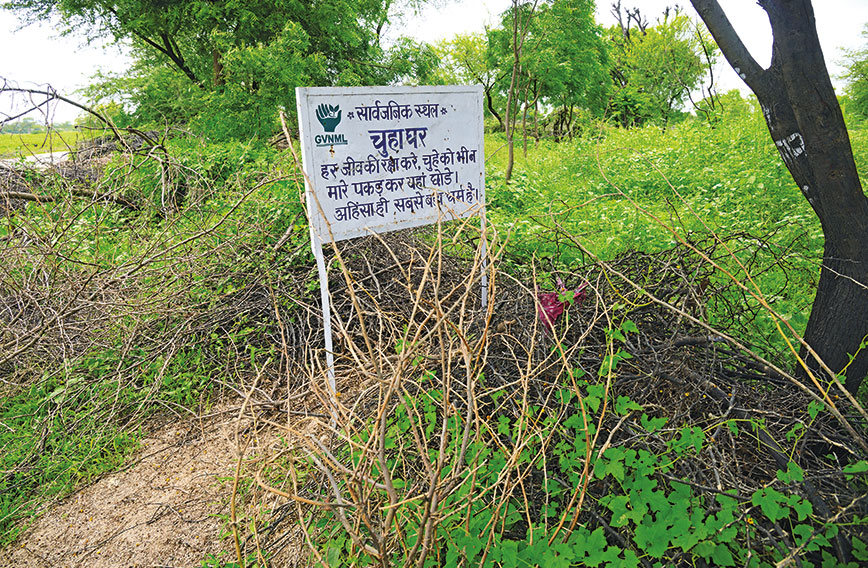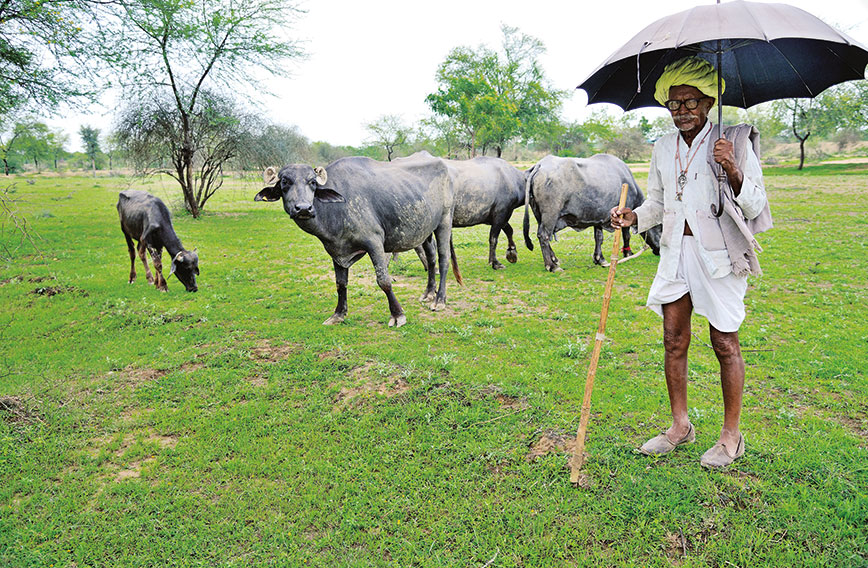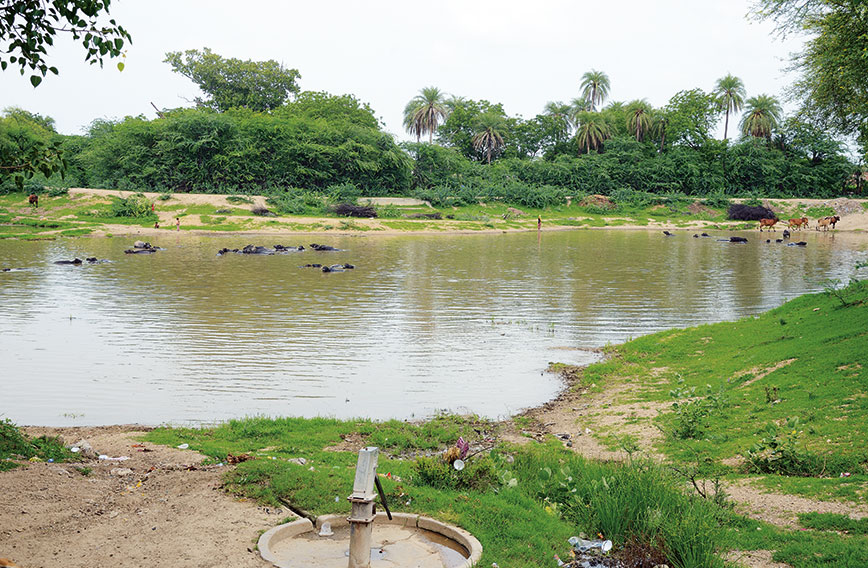
Laxman Singh sitting next to a water body in Laporiya explaining how the intricate Chauka system works
Laxman Singh
The village of Laporiya in Jaipur district, Rajasthan, gets just 300 mm of rainfall in a year, but it is not deficient in water. How does that work out? It is thanks to conservation and controlled community-based consumption.
It wouldn't have been possible if Laxman Singh, more than two decades ago, hadn't decided to save his village through water harvesting, growing appropriate crops and stopping the use of pesticides.
He saw survival in restoring nature's balance. In bringing back the water cycle. Trees were needed. So too animals and birds.
Since Laporiya needed its pastures and there wasn't the space to build too many tanks, Laxman Singh devised the chauka, which consists of ridges of mud in a rectangular shape, to keep rainwater standing and allow it to percolate into the ground.
Laporiya's fields are full of crops. From its tree cover you wouldn't imagine that it lives in constant combat with drought. Laxman Singh has shown what communities with very little water can do to get nature back on their side.
Below is a piece that appeared in Civil Society's September-October 2017 edition. Read on.
The village of Laporiya in Rajasthan gets very little rainfall. The average for 18 years is less than 500 mm a year. In recent years it has been 300 mm. There has been the odd big downpour, but mostly drought-like conditions prevail.
It is scary and stressful to live in a desert region with very little rain and no other sources of water. Laporiya, though in Jaipur district and a few hours from the state capital, has seen some tough times when nothing would grow in its fields and young people left in search of a better life. But that was long ago. Now, even though it still doesn’t rain much, the lack of water is the last thing that residents of this village worry about.
     |
A passionate campaign launched by them 25 years ago to harvest the little rain they get and plant trees has sent groundwater levels up. It has ensured the wells always have water and their lives are better for it. It takes long for a village to go from no-water to water but Laporiya is proof that it can be done.
The inspiration for the campaign is Laxman Singh, then a young scion of the main landowning family in the village and now an elder at 61.
With water available, the village is full of trees and birds. The pastures have grass and the fields have crops. Healthy cows, goats and sheep are in abundance and milk sales has boosted local incomes.
The transformation is difficult to imagine. Laporiya these days bears no resemblance to the dying village it once was. It is as though a wizard has been at work.
Laxman Singh, who had only studied up to Class 10, intuitively felt that collecting rainwater and putting it back into the earth was the key to stemming the decay.
He began by rallying villagers together to repair the single talaab or tank in the village. Soon they built two more big tanks.
 The right moisture brings back grass to pastures
The right moisture brings back grass to pastures
But his outstanding and unique contribution over the years has been the invention of the Chauka system which lets rainwater collect and sink into the pastures.
A village that had gone to pieces is now an emblem of environmental balance and harmony. It is a model for 57 nearby villages, which have also adopted the Chauka system.
More importantly, they have pledged themselves to conservation by agreeing not to cut trees or hunt animals and birds.
Once a year, they take out a procession over several days to keep the spirit of the campaign going. They have also, very significantly, changed the way they live every day. It can be seen in multiple bio-reserves created to preserve gene pools of local plants and trees. Different names have been given to their talaabs depending on the purpose. There are enclosures and feeding platforms for birds. A memorial has been built for a rabbit killed by hunters as a reminder that wildlife shouldn’t be destroyed. A clump of trees has been designated Chuha Ghar, or House for Rats, where rodents must be released, not killed.
 The Chuha Ghar where rats are released and not killed
The Chuha Ghar where rats are released and not killed
Laporiya and its neighbouring villages are an example of how people can come together for their ecological well-being. From being a young man worried about his village’s future, Laxman Singh has graduated to being a firm but benevolent elder.
Coming from the Thakur family in the village gave him a social advantage. Villagers were wired to listen to him. He is also by temperament persistent and persuasive and has an endearing sense of justice.
But for all these attributes, nothing would have changed were it not for the Chauka which revived the pastures and made harvesting of rainwater efficient.
INVENTING THE CHAUKA
So, what exactly is a Chauka and how did the idea come to Laxman Singh?
“We needed a system which could provide the grass on which our animals could graze and recharge groundwater,” recalls Laxman Singh. “You can recharge groundwater by having tanks. But how many tanks will you build on the 400 bighas of pastures that we have? The land would be destroyed. Also, we don’t get the kind of rainfall needed to fill a large number of tanks.”
“On the other hand, when we went into the pastures while it was raining we found that the water on the ground would quickly disappear when it stopped raining,” Laxman Singh explains.
“Nature’s way is to make the land slope. It is the law of nature that water will travel — to aquifers, streams, small rivers, big rivers and finally the sea. So, I felt we should not go against Nature. Instead, we should learn from it.”
The Chauka was, therefore, designed to suit the slopes of the pastures. It would slow the flowing away of rainwater and give it time to percolate into the ground. It would also trap the water at a height at which it wouldn’t interfere with the growth of grass. It was important that the pasture remain a pasture and not become a water body because then grass would stop growing in it.
A Chauka consists of ridges of mud and has four sides in the shape of a rectangle with one side open. At the maximum, a Chauka will hold nine inches of water. If more than nine inches of water collects, grass will not grow. But it is also important to go from nine inches down to zero because the water must keep moving even as it collects.
Also, different kinds of grass grow at lower heights of the Chauka. Animals need the variety. Goats go for the thorny grass. Cows and buffaloes prefer the leafy varieties.
Each Chauka is designed to suit the slope of the pasture in which it is located. All the Chaukas combine to form a larger design so that the flow of water can be directed.
The Chaukas of the 58 villages together make up a much larger design. Because of this, on the rare occasion there is heavy rainfall, these villages don’t flood since the water circulates. In 2010, when there was such a downpour, there were floods all over Rajasthan, but not here.
“It doesn’t require much intelligence to make a water tank or a road. But if you set out to collect rainwater, it is a complex task. The amount of water you collect will determine what grows there. So, through trial error, we arrived at nine inches of water. It was based on studying Nature,” says Laxman Singh.
 Cows, buffaloes and sheep thrive on Laporiya's verdant pastures
Cows, buffaloes and sheep thrive on Laporiya's verdant pastures
“When walking around in the pastures we found natural hollows which were nine inches deep. Grass was growing in them. It is so even today and if you walk around during the rains or at any other time you will see this. If there is a hollow of three feet, water at that depth will destroy the soil. Grass will not grow, as happens in a tank, where water is kept standing for a long time.”
“We wanted a system that would not just trap water but also promote microbial activity that would make the topsoil rich. Every year fresh grass should grow. Every year the ecosystem should go through its cycles. Every year our animals should get fresh grass to eat. Cows and goats eat different kinds of grass. Birds and butterflies draw on different kinds of flowers. We wanted all this diversity to continue,” says Laxman Singh.
The Chauka system wasn’t built in a day because several attempts had to be made to replicate the multiple nuances in Nature. It was a complex task and it meant failing more than once because Nature’s way is not easy to understand, even for someone as sensitive as Laxman Singh.
To validate their ideas, Laxman Singh and other villagers went to university departments where they were ridiculed.
“They told us the solution was to build contour bunds. When we said that contour bunds weren’t the solution in Laporiya, they laughed at us and said contour bunds were being used the world over,” says Laxman Singh.
The villagers looked closely at the contour bunds the government was building in the area. These were long and unwieldy. Instead of slowing down the rainwater, they speeded up its flow. The result was the bunds would breach and the water would rush into the stream below.
Seeing the bunds fail made them even more convinced that they needed a solution suited to local conditions and based on their own observations and knowledge.
ANUPAM MISHRA'S INFLUENCE
A major influence on Laxman Singh’s thinking was Anupam Mishra of the Gandhi Peace Foundation (GPF).
Mishra, who passed away in December last year, was India’s foremost authority on traditional water systems like step-wells, tanks and ponds.
He was a painstaking grassroots researcher with invaluable insights into the traditions associated with community use of water. He was also intuitive in his understanding of the working of Nature.
“Anupamji taught us that everything we do should be in harmony with Nature and by learning from it,” says Laxman Singh. “He also emphasised the importance of working in our immediate environs because only we could understand our local problems and arrive at lasting solutions.”
“His style was an informal one whereby he would make suggestions and drop ideas and it was up to us to pick them up.”
Mishra would move around the pastures and make suggestions on how the Chaukas could be made more efficient.
He made a significant contribution to the building of three tanks in Laporiya. At first, the tanks were being made any which way. It was only after Anupamji entered their lives that Laxman Singh and fellow villagers realised the subtleties of tank design.
“We had a broad idea that we needed tanks and we had begun making them. But we knew nothing about the rich traditions and the finer points of design and engineering. These we learnt from Anupamji.”
At the time Laporiya was building three tanks Mishra arrived, and asked: “You have made the tanks but what names have you given them. A tank needs a name. How will you refer to it? You can’t say this tank, that tank….”
 The Phool Sagar tank has water even in a lean year
The Phool Sagar tank has water even in a lean year
So, the first tank came to be named Ann Sagar, which meant it was for irrigation to grow food. Another was called Phool Sagar and was meant to raise groundwater levels so that the roots of plants and trees could always be nourished. The third was called Dev Sagar or the tank of the gods and was also meant to raise groundwater levels.
No water could be drawn from Phool Sagar and Dev Sagar though animals could drink from them. It is still so today.
Laporiya is an example of what can be achieved when a village takes charge of its destiny. It shows that water harvesting by itself will not do. Lifestyle changes are needed and respect for Nature is important.
Laporiya also shows us that the best solutions are those that are designed for local conditions. The Chauka system is specific to this area and it won’t do to mindlessly replicate it elsewhere.
On the terrace of a beautiful old building belonging to his family, Laxman Singh has an office with a computer and phones. There is a split air-conditioner.
A desk with an imposing chair adds to the formality. He and his brother, Jagveer, pore over pictures and maps as they explain the Chauka’s working to us. They have an organisation called the Gram Vikas Navyuvak Mandal Laporiya.
These trappings are needed to coordinate innumerable activities in a day. Laxman Singh continues to spend time out in the fields and pastures.
It appears that he knows every inch of the land. Laporiya’s strength is in the way people of the village have come to respect water and restructured their lives based on what they have. Water harvesting is just one of the many things they have learnt to do right.
Umesh Anand and Photographer P. Anil Kumar visited Laporiya to speak to Laxman Singh and understand the Chauka system.
Comments
Currently there are no Comments. Be first to write a comment!



